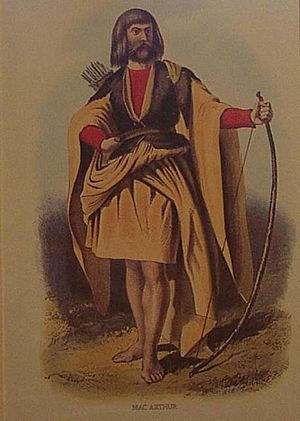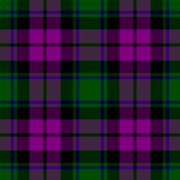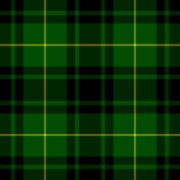Clan Arthur facts for kids
Quick facts for kids Clan Arthur |
|
|---|---|
| Clann Artair | |
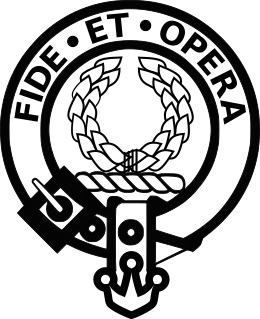
Crest: Two laurel branches in orle Proper
|
|
| Motto | Fide et Opera |
| Slogan | Eisd, o Eisd! |
| Profile | |
| District | Argyll |
| Plant badge | Wild Thyme |
| Chief | |
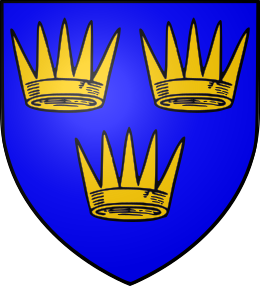 |
|
| John Alexander MacArthur of that Ilk | |
| The Chief of Clan Arthur | |
Clan Arthur or Clan MacArthur (in Scottish Gaelic: Clann Artair) is a Highland Scottish clan. A clan is like a large family group, often with a shared history and a chief. The MacArthurs once owned land near Loch Awe in Argyll, Scotland. Many people say Clan Arthur is one of the oldest clans in this area.
Clan Arthur and Clan Campbell actually come from the same family tree. For a while, the MacArthurs even thought they were the most important family in the clan, more so than the Campbells! Some MacArthurs from the Isle of Skye were also part of the MacDonalds of Sleat and were the official pipers (bagpipe players) for the MacDonalds of the Isles.
Sadly, in the late 1700s, the chief of Clan Arthur passed away without a child to take his place. This meant the clan didn't have a leader for a very long time. But don't worry! In 2002, after about 230 years, the first new chief of Clan Arthur, James Macarthur, was officially recognized.
Contents
History of Clan Arthur
Early Beginnings
The Campbell clan first appeared around the time of King Alexander III (who ruled from 1249 to 1286). Back then, the Campbells were split into two main groups: the Mac Cailinmor and the Mac Arthur.
A historian named William F. Skene wrote that during the rule of King Robert I (1306–1329), the Mac Cailinmor group didn't own much land in Argyll. But the Mac Arthur group, led by Arthur Campbell, had a lot of land in an area called Garmoran. This was the original home of the Campbells. Skene believed that Arthur Campbell was the main leader of the clan until the time of James I of Scotland.
Arthur Campbell of the Mac Arthur group and Neil Campbell of the Mac Cailinmor group both supported Robert the Bruce during his fight for Scotland's independence. Because of their loyalty, the king gave them many lands that had been taken from his enemies. Arthur Campbell was even made the keeper of Dunstaffnage Castle and given a lot of land in Lorne.
Later, during the reign of King David II, the Mac Cailinmor group started to become much stronger. This was partly because Sir Neil Campbell had married King Robert I's sister. The Mac Arthur group tried to stop the Mac Cailinmor from taking over the clan. Arthur Campbell even got a special paper from the king that said he only had to answer to the king for his lands, not to anyone else.
A Turning Point
In 1427, King James I held a big meeting in Inverness and called many Highland chiefs to attend. Sadly, Iain MacArthur, who was the chief of the MacArthurs at the time, was one of the chiefs who were executed by the king. He was known as "a great prince among his own people and leader of a thousand men."
After Iain MacArthur's execution, the MacArthurs lost almost all their lands. They only kept Strachur and some areas in Perthshire like Glenfalloch and Glen Dochart. From this point on, the Mac Cailinmor group became the main leaders of the clan, and the Campbells continued to grow in power.
Finding a New Chief
In 1771, Patrick MacArthur, who was the chief of Clan Arthur, passed away in Jamaica. He didn't have any sons to take his place. This meant that the official title of Chief of Clan Arthur was lost for a long time.
In 1986, some important members of Clan Arthur decided to find a new chief. They hired a special researcher to look through old family records. The goal was to find someone alive today who was related to the old chiefs of Clan Arthur.
The research showed that the main line of MacArthur chiefs, called the MacArthurs of Tirivadich, could be traced back to a man named John MacArthur of Tirivadich in 1495. The main family line had ended, but they found a living relative through one of John MacArthur's younger grandsons. This person was a Canadian man named James Edward Moir MacArthur.
In 1991, clan members held a special meeting to discuss the new chief. They decided that James Edward Moir MacArthur should ask the Lord Lyon, who is Scotland's expert on coats of arms and clans, to recognize him as the Clan Commander. Ten years later, he did, and in 2002, James Edward Moir MacArthur was officially recognized as the rightful heir to the MacArthur family's coat of arms. This meant he was entitled to be the chief of Clan Arthur!
In April 2003, clan members officially welcomed him as their chief. He was the first official chief of the clan in about 230 years! When he passed away in 2004, his son, John Alexander MacArthur of that Ilk, became the new chief. The current chief of Clan Arthur is part of the Standing Council of Scottish Chiefs, which is a group that represents all the Scottish clans.
Clan Tartans
A tartan is a special pattern of colored lines that represents a Scottish clan. Each clan usually has its own unique tartan.
The most common MacArthur tartan used today was first published in the Vestiarium Scoticum in 1842. This book was created by people known as the "Sobieski Stuarts", and it has been proven to be a forgery. Interestingly, some MacArthurs from the Isle of Skye were the official bagpipe players for the MacDonalds. Because of this, their tartan looks similar to the MacDonald, Lord of the Isles tartan.
Another MacArthur tartan is the MacArthur of Milton Hunting tartan. This one is thought to be older and is similar to the Campbell tartan. It comes from a book called Wilson's '1823' Sample Book.
Clan Symbols
The current chief of Clan Arthur is John Alexander MacArthur of that Ilk. He is the only person legally allowed to use the special arms of the MacArthur name in Scotland. The design on his shield is Azure, three antique crowns Or. This means it's a blue shield with three old-fashioned gold crowns. This design is similar to some of the symbols linked to the legendary King Arthur.
Clan members can wear a special crest badge. This badge shows the chief's heraldic crest and his heraldic motto. The chief's crest is "two branches of bay in orle, proper," which means two bay tree branches forming a circle.
The chief's heraldic motto is FIDE ET OPERA. This is Latin and means "by fidelity and work" or "by faith and work." The clan's slogan is EISD O EISD, which is Scottish Gaelic for "Listen!, O Listen!" The clan also has a special plant badge, which is Wild Thyme.
See also


